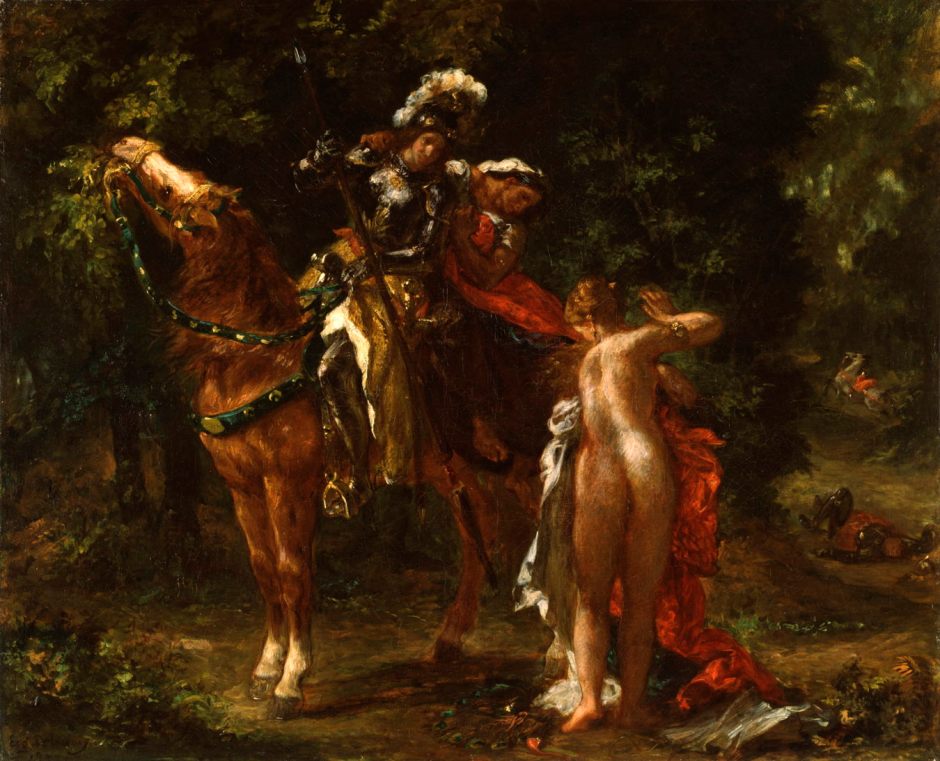There has been a long-standing debate in European painting between those who place greater emphasis on form and ‘drawing’, and others who rank colour more highly. Although it has older origins, this crystallised in the Southern Renaissance, when artists in Florence and northern Italy held form, or disegno, as of paramount importance, and those in Venice opted for colour, or colore: the rivalry of disegno and colore that was to dominate the aesthetics of painting for centuries.
This persisted well into the nineteenth century, when David’s neoclassicism was held to follow disegno, and Delacroix was considered a colourist. Unfortunately this was confounded by later analysis of Delacroix’s style, which was conducted in the light of colour theory developed in the latter nineteenth century. In this article I’ll try to be more objective.

I start with his first success at the Salon, The Barque of Dante from 1822, which shows one of his early experiments with colour. In the detail below, water droplets on the bodies of those surrounding the boat contain at least three different colours: their reflected highlights are pure white, the rest of the body of the droplet and its trail are the dark green of the water below, and the droplet itself has a shadow of the same pink that Delacroix uses to shade flesh. Their overall effect is of an unusually three-dimensional and realistic droplet.

Although earlier painters had experimented with colour separation, this appears to be novel, and an early use of colour contrast between dark green and pink.

Three years later, he painted A Mortally Wounded Brigand Quenches His Thirst, which wasn’t shown until the Salon of 1827-28. Its lone figure is pure colore and no disegno at all, and this resembles an oil sketch rather than a finished work for exhibition.

His early radical approach reached a peak in The Death of Sardanapalus, most overtly in this small copy he made in 1844, where he had no inhibitions imposed by the conventions of the Salon.

Details above and below show how painterly this version is, and his use of complimentary red and green for flesh.

Delacroix appears to have been chastened by his experience with Sardanapalus at the Salon, and returned to more conventional style.

His Women of Algiers in their Apartment from 1834 is less challenging, and its colour harmonies were more widely appreciated among other artists and critics. While he placed greater emphasis here on form and detail, it’s still thoroughly colourist.
Once Delacroix had fully established his art, and his paintings were decorating some of the most important buildings in the whole of France, he was able to innovate more actively again, particularly in his smaller narrative easel paintings.

In Marfisa and Pinabello’s Lady from 1852, he expressed this comical scene from Ariosto’s epic poem Orlando Furioso in pure colour, and has almost completely avoided its forms.

Eight years later, and shortly before he completed his paintings in the Church of Saint-Sulpice, he returned to Ariosto for Angelica and the Wounded Medoro (c 1860) and its dissolution of form.

Delacroix’s final painted statements on the rivalry between disegno and colore came in his Hartmann Seasons, here that of Winter (1856-63). This was surely the groundwork for the next generation.
References
Barthélémy Jobert (2018) Delacroix, new and expanded edn, Princeton UP. ISBN 978 0 691 18236 0.
Patrick Noon and Christopher Riopelle (2015) Delacroix and the Rise of Modern Art, National Gallery and Yale UP. ISBN 978 1 857 09575 3.
Lucy Norton (translator) (1995) The Journal of Eugène Delacroix, 3rd edn, Phaedon. ISBN 978 0 7148 3359 0.
Arlette Sérullaz (2004) Delacroix, Louvre Drawing Gallery, 5 Continents. ISBN 978 8 874 39105 9.
Beth S Wright (editor) (2001) The Cambridge Companion to Delacroix, Cambridge UP. ISBN 978 0 521 65077 1.

